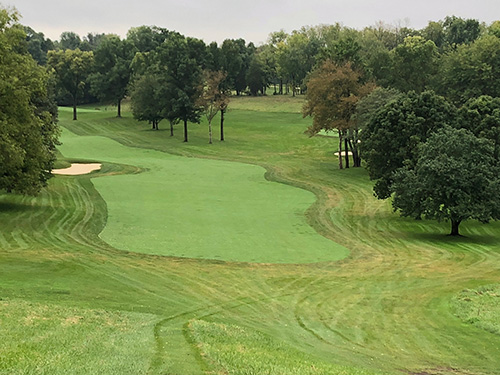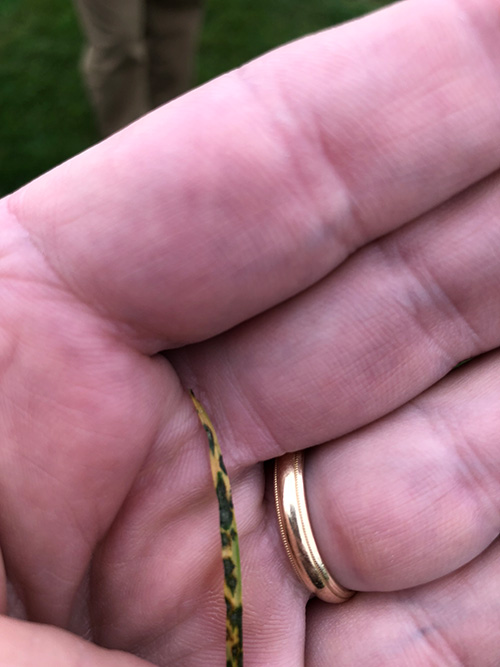Gray Leaf Spot is Just Around the Corner
Late summer weather largely affects the extent of damage from gray leaf spot (GLS) (Pyricularia grisa). Hot, humid weather with extended dew periods and frequent thunderstorms favor infection of perennial ryegrass and tall fescue fairways, intermediates, and roughs in much of the Midwest, Northeast, and Mid-Atlantic. However, reports of significant GLS damage occur every year regardless of weather. Below are some key takeaways to help limit GLS this year.
Biology
- Gray leaf spot does not typically overwinter in the northern US, but blows in with weather fronts from the south
- Disease starts in higher mowed turf like roughs and spreads quickly into lower mowed areas with traffic and water
- Infection can occur at temperatures as low as 68°F but is favored by temps between 82-90°F
- Leaf wetness is critical for infection:
- At 68-75°F, 21-36 hours of continuous leaf wetness is typical for infection
- At 82-90°F, only 9 hours of continued leaf moisture is needed for infection
- Disease will typically cease with first heavy frost
Cultural control
- Reduce succulence of perennial ryegrass through minimized nitrogen and irrigation in late summer
- Use slow-release N for the September N application or wait until weather has passed to initiate fall fertilization
- Overseeding with GLS-tolerant perennial ryegrass is highly effective long-term. Even GLS- tolerant perennial ryegrass is not resistant as seedlings, so overseeding should be delayed until after the bulk of the hot, wet weather has passed. Many superintendents will overseed with GLS-tolerant ryegrass in spring and fall, but this will impact your crabgrass/goosegrass control schedule
Fungicidal control
- Frequent scouting is critical in staying ahead of GLS. This disease usually develops first in the roughs grown in shade where leaf wetness is the longest. Monitor these areas frequently during the summer months.
- Preventative control is critical in areas with traditional gray leaf spot activity. Early preventative control is justified since GLS can quickly devastate large areas, disrupting play and requiring expensive and time-consuming overseeding efforts
- Like all diseases, early applications to minimize inoculum is critical for most effective long-term control. Ensuing applications should be made at 14-21 day intervals, with tighter intervals during conducive weather
- Early August is when applications typically begin, but should be moved up a week or two during hot humid summers
- Since infections begin in roughs, consider an additional pass or two in the roughs when treating fairways
- Once infection is started and damage seen, curative control is marginally effective. A combination of DMIs, QoI’s, chlorothalonil, and thiophanate-methyl should be used at higher rates and shorter intervals to limit damage
- In areas where GLS is common, some strains have shown resistance to the strobilurin class of chemistry (QoI fungicides). Below is a suggested program with effective chemistries that can be rotated as needed during times of gray leaf spot activity
- Deniscor® is Envu's newest fungicide and it is highly effective on gray leaf spot
- Need more info? – Read and follow all label directions. Contact your Envu Area Sales Manager if you need assistance
Product and rates/1000 sq ft for gray leaf spot control (Other than state of New York)
| Product & Rates per 1000 sq. ft1,2 | ||||
| Week | Standard Program | Rate | Program if Qol Resistance is Present | Rate |
| 1 Aug |
Densicor® + Daconil® Weather Stik®3 |
0.196 fl oz 3.6 fl oz |
Densicor + Daconil Weather Stik |
0.196 fl oz + 3.6 fl oz |
| 15 Aug |
Compass OR Exteris® Stressgard OR Tartan® Stressgard |
0.25 oz 5-6 fl oz 2 fl oz |
Mirage Stressgard + Daconil Weather Stik |
1.5 fl oz + 3.6 fl oz |
| 1 Sep |
Mirage® Stressgard + Daconil Weather Stik |
1.5 fl z + 3.6 fl oz |
Densicor + Danconil Weather Stik |
0.196 floz 3.6 fl oz |
| 15 Sep |
Densicor + Daconil Weather Stik |
0.196 fl oz 3.6 fl oz |
3336®3 F | 4 fl oz |
1ALWAYS READ AND FOLLOW LABEL DIRECTIONS
2Based on typical summer weather, consider starting earlier when summer temperatures and rainfall are above average
3All trademarks are the property of their respective owners
Product and rates/1000 sq ft for gray leaf spot control1,2 (New York Only)
| Product & Rates per 1000 sq. ft1,2 | ||||
| Week | Standard Program | Rate | Program if Qol Resistance is Present | Rate |
| 1 Aug |
Mirage Stressgard + DaconiWeather Stik4 |
1 fl oz 3.6 fl oz |
Mirage Stressgard + Daconil Weather Stik |
1 fl oz + 3.6 fl oz |
| 15 Aug |
Compass OR Exteris Stressgard OR Tartan Stressgard |
0.25 oz 5-6 fl oz 2 fl oz |
Bayleton + Daconil Weather Stik |
1.5 fl oz + 3.6 fl oz |
| 1 Sep |
Mirage Stressgard + Daconil Weather Stik |
1 fl z + 3.6 fl oz |
Mirage Stressgard + Daconil Weather Stik |
0.196 floz 3.6 fl oz |
| 15 Sep |
Compass OR Daconil Weatherstik |
0.196 fl oz 3.6 fl oz |
3336®3 F |
1 fl oz + 3.6 fl oz |
1ALWAYS READ AND FOLLOW LABEL DIRECTIONS
2Mirage Stressgard is limited to three 1 fl oz applications per 1,000 sq ft per year
3Based on typical summer weather, consider starting earlier when summer temperatures and rainfall are above average
4All trademarks are the property of their respective owners e.
.Gray leaf spot is difficult to identify and can be confused with many other foliar diseases (Envu)

Gray leaf spot infection and damage begins in higher mowed areas like roughs. Control practices should include roughs to prevent spread into perennial ryegrass fairways and tees. (Envu)

